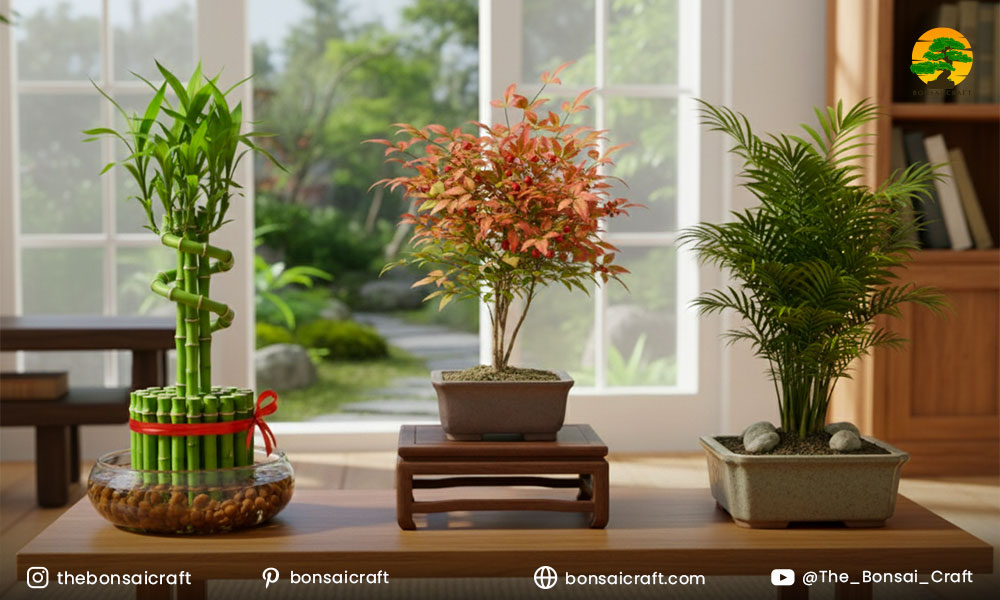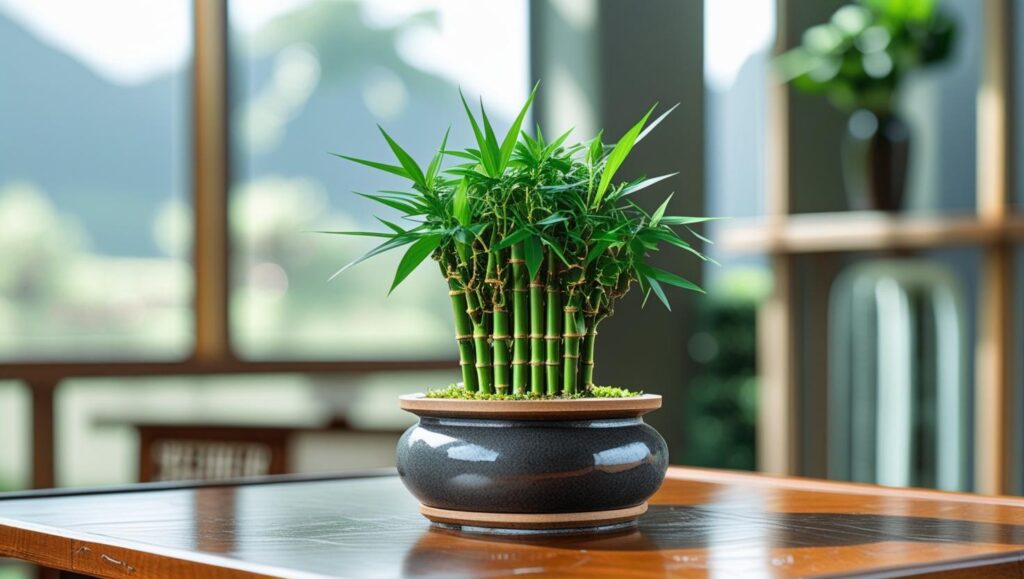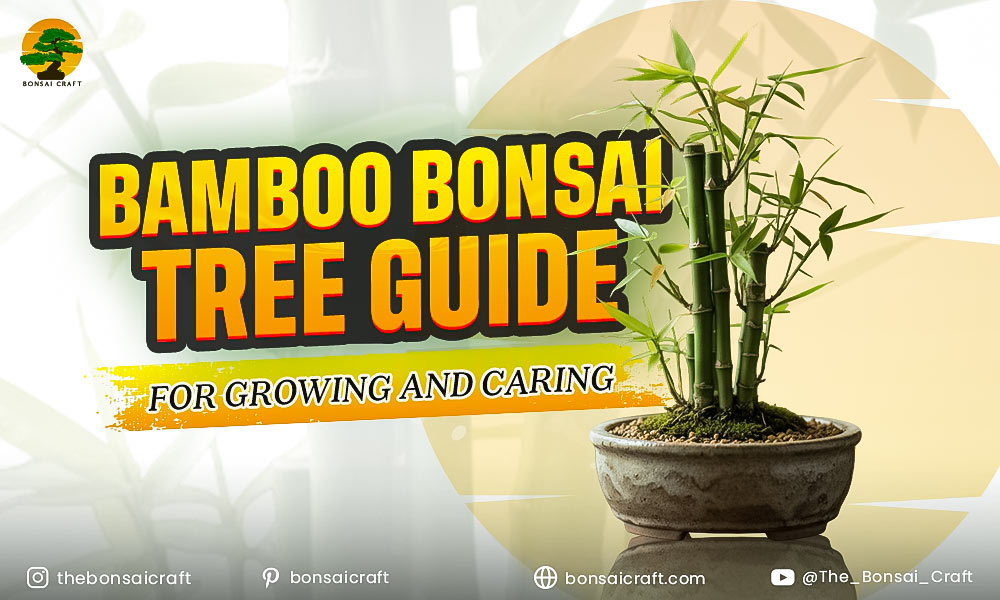
A bamboo bonsai tree is not just a plant; it’s a piece of living art that has captured the fascination of bonsai lovers worldwide. Combining the delicate charm of bonsai with the sturdy resilience of bamboo, bamboo bonsai has grown into a symbol of good fortune, prosperity, and balance. Unlike traditional bonsai, which often involves harder wood trees, bamboo bonsai plants offer a lighter, more flexible option that’s ideal for those who appreciate easy-to-care-for indoor greenery with a touch of elegance. Whether you’re a seasoned bonsai enthusiast or a beginner, this guide will walk you through everything you need to know about growing and caring for your bamboo bonsai tree, ensuring you can cultivate it into a healthy, thriving plant.
What is Bamboo Bonsai?
Bamboo bonsai refers to a miniature bamboo plant cultivated in a small pot, shaped and pruned to maintain a bonsai form. It’s popular for its symbolism of good fortune and positive energy.
Bamboo bonsai is the art of cultivating bamboo into a small, miniature tree. Despite its appearance, bamboo bonsai tree doesn’t belong to the traditional hardwood species typically used for bonsai. Instead, it is crafted from bamboo plants, specifically chosen for their thin, elegant stalks and adaptability. Unlike more rigid trees, bamboo offers a sense of tranquility and fluidity, making it ideal for a bonsai design. The primary appeal of bamboo bonsai trees lies in their symbolism. Bamboo is known for its strength, resilience, and connection to prosperity and good luck, making it a beloved choice in various cultures worldwide.
Growing a bonsai bamboo tree requires both patience and precision, but the rewards are well worth the effort. The bamboo plant itself is relatively easy to care for, requiring attention to detail for optimal growth. From its vibrant green leaves to its tall, slender stalks, a bamboo bonsai plant has an air of grace and beauty that complements any indoor space.
Types of Bamboo Bonsai Trees
Lucky Bamboo Bonsai
Lucky bamboo bonsai is a popular variety of bamboo bonsai associated with good fortune. It’s often used in Feng Shui practices and can be grown indoors.
Perhaps the most famous of all the bamboo bonsai trees is the lucky bamboo, or Dracaena sanderiana. As the name lucky bamboo suggests, this plant is not true bamboo. It resembles bamboo and is treated like one. This variety is very simple and quick to grow, making it much loved by novice bonsai enthusiasts. It is commonly found around the house or in the office, particularly due to its symbolic value in Feng Shui. In Feng Shui, lucky bamboo is said to offer wealth, positive vibes, and fortune to its keeper. Hence, the decorative piece is very common to find.
This form of bonsai is more resilient in the presence of low light, making it more suited to indoor use. In addition to soil and water, lucky bamboo can be grown in a variety of shapes including curls and braids.
Heavenly Bamboo Bonsai Tree
Heavenly bamboo bonsai, or Nandina domestica, is another popular choice for bonsai enthusiasts, known for its vibrant leaves and red berries.
Heavenly bamboo bonsai (Nandina domestica) is not a true bamboo, but it is an option for people fascinated with bonsai. This specific bonsai is known for its vivid and colorful leaves that change with the four seasons. During the spring and summer, its leaves are bright green, while in the fall, they transform into fiery reds and oranges. In the winter, the heavenly bamboo bonsai yields small clusters of red berries, which increase its beauty further.
Heavenly bamboo bonsai (Nandina domestica) is not a true bamboo, but it is an option for people fascinated with bonsai. This specific bonsai is known for its vivid and colorful leaves that change with the four seasons. Unlike lucky bamboo, which is grown exclusively indoors, the heavenly bamboo bonsai tree performs best when sited outdoors in the sun. It also does well indoors, but not as brightly as a lucky bamboo. This type can also be arranged into bonsai forms and adds color to a space, which makes it a great addition to any bonsai collection.
Bamboo Palm Bonsai
Bamboo palm bonsai is an elegant indoor plant that can be cultivated as a bonsai. It’s perfect for low-light environments and has a tropical look.
Bamboo palm bonsai (Chamaedorea seifrizii) is a great alternative when looking for bamboo bonsai to grow indoors. It combines the tropical appeal of flowering palms with the small size of a bonsai. As the name suggests, the bamboo palm bonsai is a true palm that flourishes in low-lit settings, making it perfect for homes or offices with no direct sunlight. Although it can survive in low-light environments, the bamboo palm bonsai still needs to be cared for to avoid brown or dry leaves. The bamboo palm’s fine-textured, arching fronds are tropical and elegant, suitable for warm-themed homes and for those who enjoy tropical aesthetics.
An additional reason why it is great to have one indoors is the bamboo palm bonsai’s air-cleansing features. Because the bamboo palm bonsai is hard to kill and easy to take care of, it is the perfect indoor plant for beginners and brown thumbed gardening enthusiasts.
How to Grow Bamboo Bonsai Trees
How to Make Bamboo Bonsai Tree
To make bamboo bonsai, start by selecting a healthy bamboo cutting, plant it in well-draining soil, and prune the shoots regularly to maintain its shape.
Your own bamboo bonsai tree can be started with a healthy cutting. A bamboo stalk can be gotten from a nursery and is a healthy cutting. Look for a healthy and straight stalk. Make sure not to overwater it, as bamboo does not do well in soggy soil. Shallow pots with pebbles and rocks at the bottom can also work, as long as they ensure proper drainage.
Don’t forget to provide the cutting with the proper lighting; indirect sunlight is best. Reshape as needed by trimming the sprouts to keep their shape and promote further sprouting. Regular maintenance of bamboo bonsai involves pruning; this will keep its height in check while avoiding overgrowth.
How to Grow Bonsai Bamboo Tree
Growing a bonsai bamboo tree requires careful attention to light, water, and pruning. Bamboo bonsai thrives in indirect sunlight and needs to be watered frequently but not overly saturated.
Creating a bonsai bamboo tree from scratch is a gradual process, but ultimately, it is a highly fulfilling endeavor. Like many plants, success is determined by specific criteria. For bamboo, the right quantity of light, water, and nutrients makes a world of difference. For example, a bamboo bonsai tree performs best when placed in bright, indirect sunlight. Direct sunlight can scorch the more delicate leaves. Moreover, bamboo needs water, but it should be watered with caution. While it needs moisture, the roots should never be submerged in stagnant water.
It is crucial to keep bamboo in a pot with good drainage. Not doing so may result in root rot. Pruning aids in shaping the plant, and as it grows, you can stylize it into your desired bonsai shape.
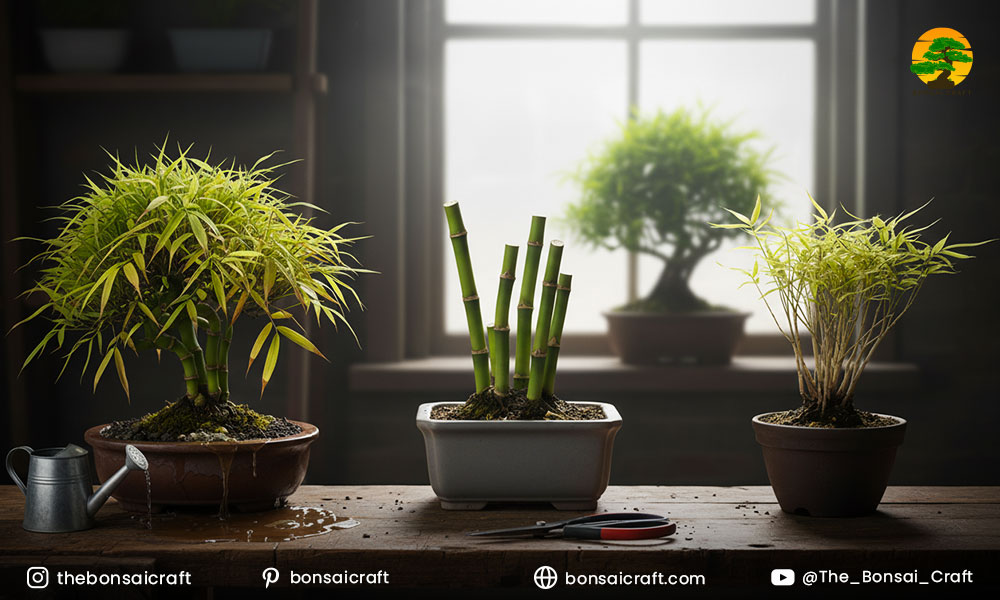
Common Mistakes to Avoid When Growing Bamboo Bonsai Tree
Bonsai Bamboo Care Tips: Overwatering
One of the most common mistakes people make when caring for bonsai bamboo plants is overwatering. Bamboo likes moisture but does not like being waterlogged. Ensure that your plant is in a pot with good drainage, and allow the soil to dry out slightly before watering again.
Mistakes With Pruning
Pruning too much or too aggressively can harm the plant, even though it is essential for shaping the bamboo bonsai tree. Always use sharp scissors or pruning shears, and remove only the necessary portions. Never attempt to remove too much, and only the parts that are essential for ensuring the health and shape of the plant.
Lack of Proper Light
While bamboo bonsai is a hardy plant, it still needs a sufficient amount of bright, indirect light to be healthy. Make sure not to keep the bamboo in corners or dark areas, as this will lead to weak and spindly growth.
Caring for Bamboo Bonsai Plants
Watering Your Bamboo Bonsai
Bamboo bonsai plants require regular watering, but should not be kept in waterlogged soil. Ensure proper drainage to avoid root rot.
Watering your bamboo bonsai is critical. Bonsai plants do best in soil that is kept moist. During warm or dry conditions, check the soil moisture regularly. Make sure the bamboo bonsai tree is not sitting in stagnant water, as that can lead to root rot. If the leaves start turning yellow or brown, it’s likely a sign of overwatering or too much moisture combined with poor drainage.
Boosting the humidity of the room helps the bonsai’s health. You can do this by misting the leaves. Remember that bamboo doesn’t like sitting in water, so the pots and other containers should have good drainage to avoid waterlogging.
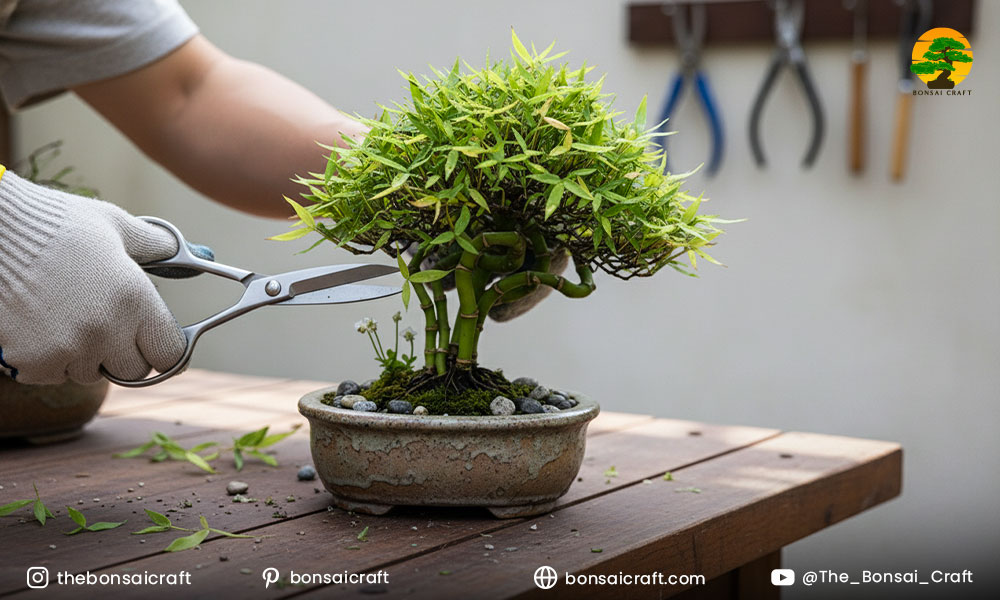
Pruning and Shaping Bamboo Bonsai Tree
Regular pruning is essential for shaping your bonsai bamboo and encouraging healthy growth. Trim back any unwanted shoots or branches.
Bamboo bonsai trees require maintenance like pruning and shaping, which are crucial for their health and shape. Regular pruning ensures the plant remains compact and bonsai in shape. While shaping the tree, make sure to eliminate any unwanted branches and shoots that might disrupt the preferred form. You may also shape the stalks by trimming them to encourage lateral growth, which results in a fuller and denser tree.
In order to avoid damaging the plant, always use sharp and clean scissors or pruning shears when doing pruning. Regular pruning also improves the aesthetics and health of the plant.
Bamboo Bonsai FAQ
Can bamboo bonsai grow indoors?
Bamboo bonsai thrive indoors as long as there is sufficient indirect sunlight and the right care.
How long does it take for a bamboo bonsai to grow?
Bamboo bonsai generally grow fast; however, it may take years to achieve their maximum size based on care and environment.
Can I grow a bamboo bonsai from a cutting?
Bamboo bonsai can be propagated from cuttings. Just take a healthy bamboo stem, and root it in water or soil, then shape it as it grows.
How often should I prune my bamboo bonsai?
A bamboo bonsai should be pruned at least every few months to keep it in good shape, as well as to clear away dead back branches or other unneeded branches.
Conclusion
Caring for a bamboo bonsai tree is a rewarding experience that adds beauty, peace, and prosperity to your space. Whether you are growing a lucky bamboo bonsai or exploring other types like heavenly bamboo bonsai, these plants offer a unique blend of elegance and symbolism. With the right care, adequate light, water, and pruning, you can enjoy the graceful beauty of bonsai in your home or office for many years. Start small, be patient, and watch your bonsai bamboo thrive into a miniature masterpiece.

